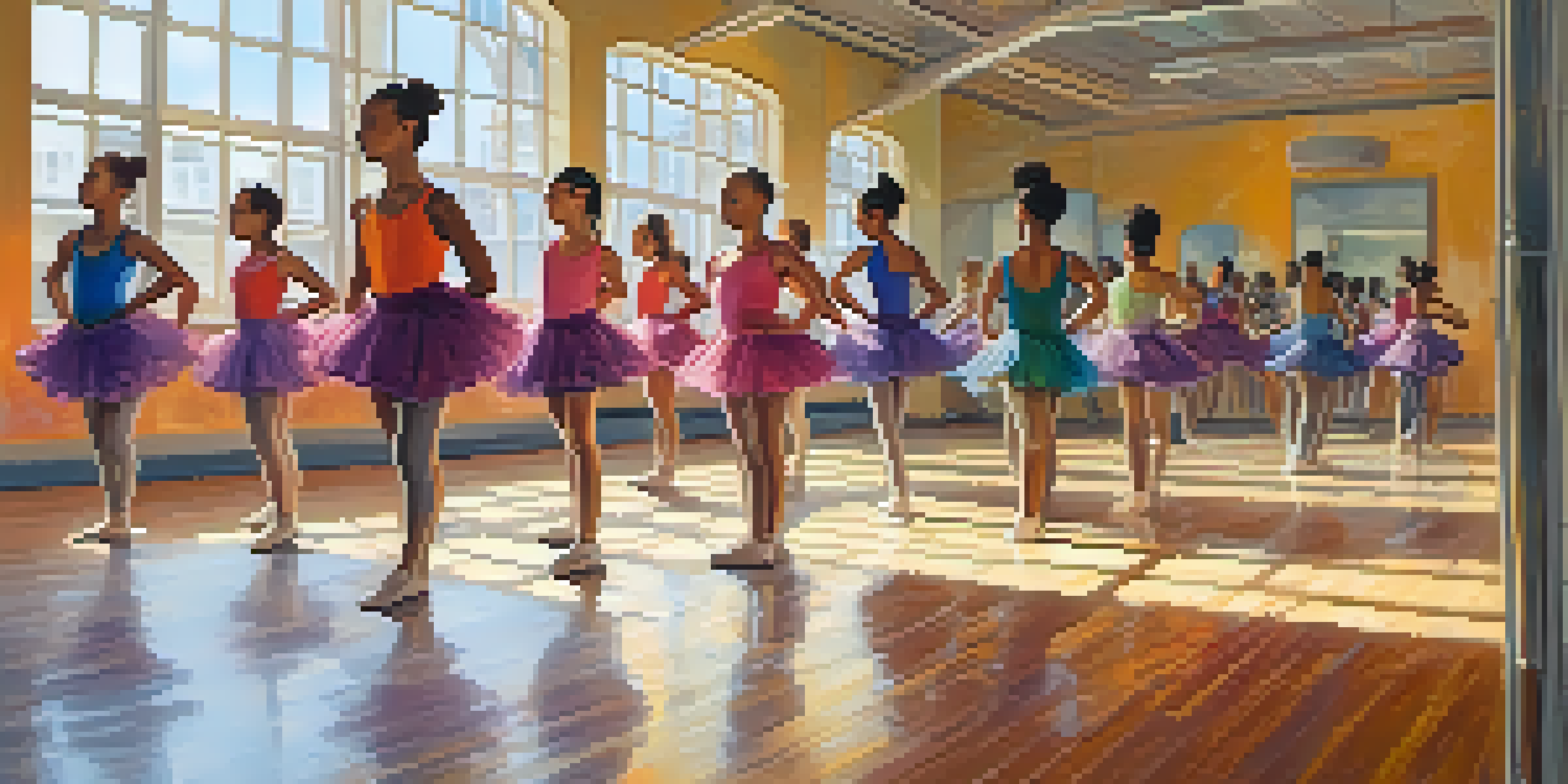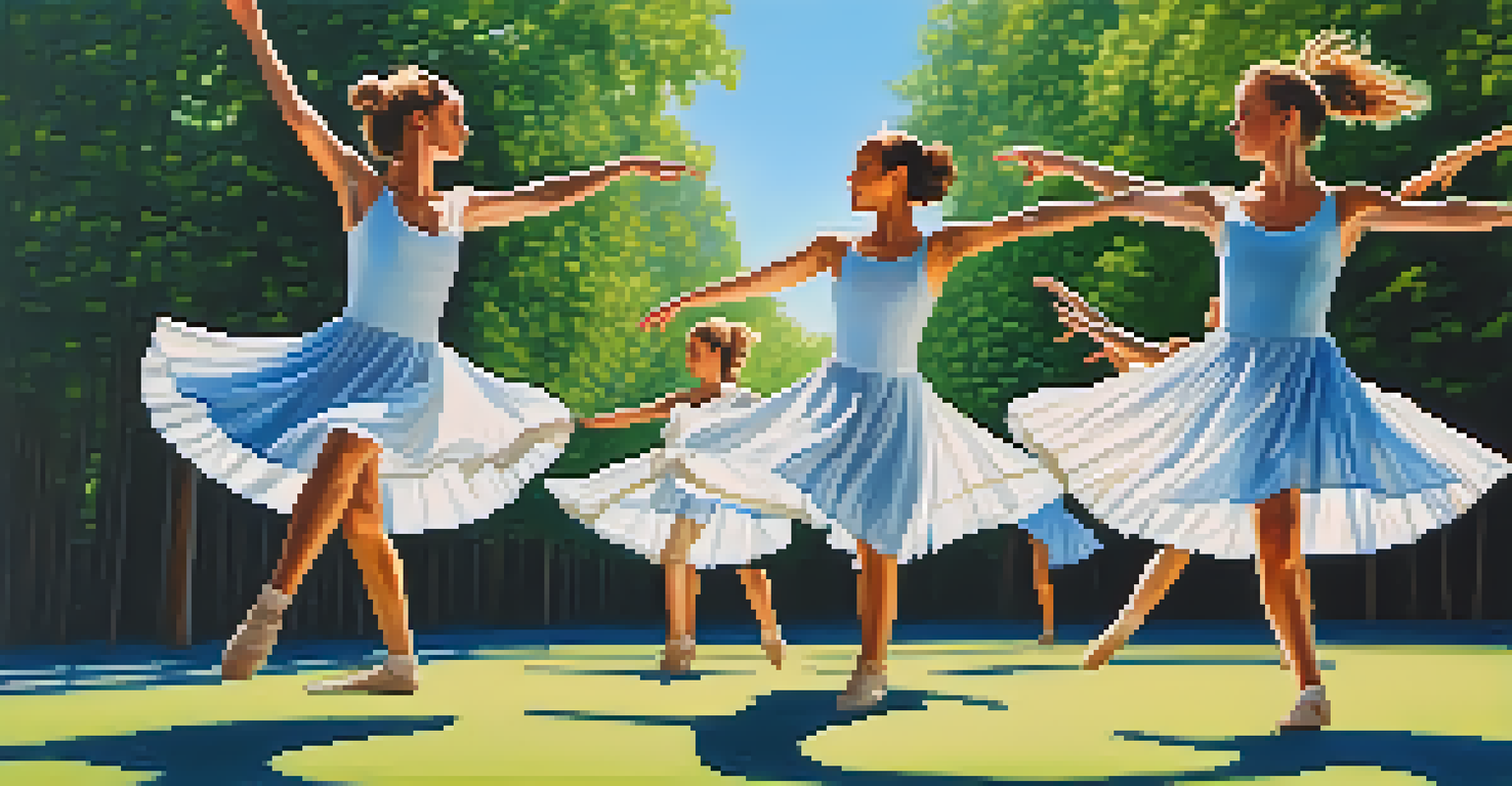The Role of Dance in Promoting Social Skills Among Youth

Dance as a Tool for Teamwork and Collaboration
Dance inherently involves working together, whether in a group or partner setting. Through choreographed routines, youth learn the importance of synchronizing their movements with others, which fosters a sense of teamwork. This collaboration not only strengthens their ability to work with peers but also creates a shared goal that they can achieve together. Over time, these experiences help them appreciate the value of cooperation in various aspects of life.
Dance is the hidden language of the soul.
In a dance class, for instance, students may need to adjust their timing or steps based on their partner’s movements. This requires active listening and quick thinking, reinforcing the idea that flexibility and adaptability are essential skills. Such experiences translate beyond the dance floor, helping young people navigate group projects in school or even collaborations in future workplaces.
Moreover, the shared experience of rehearsing and performing together deepens friendships and builds community. As youth engage in dance, they create bonds that enhance their social networks. These connections encourage open communication and mutual respect, both vital components of effective teamwork.
Enhancing Communication Skills Through Dance
Dance is a unique form of non-verbal communication, allowing youth to express emotions and concepts without words. As they learn various styles and techniques, they develop a keen sense of body language, which is crucial for effective interpersonal interactions. This understanding of non-verbal cues enhances their ability to read situations and respond appropriately in social contexts.

For example, in partner dances, such as salsa or ballroom, dancers must rely on subtle signals from their partners to execute moves smoothly. This practice sharpens their ability to communicate effectively, as they learn to interpret and respond to their partner’s cues. As they become more proficient in these dances, they often carry these communication skills into their everyday interactions.
Dance Fosters Teamwork Skills
Through synchronized movements and shared goals, dance teaches youth the importance of collaboration and adaptability.
Additionally, group dance performances require coordination and clarity in communication. Dancers must articulate their ideas during rehearsals and provide constructive feedback to one another. This collaborative environment fosters an openness that encourages dialogue, boosting their confidence in expressing themselves both in dance and in life.
Building Confidence Through Dance Experiences
Participating in dance can significantly boost a young person’s self-esteem. Each step they master and each performance they complete contributes to a sense of accomplishment. This growing confidence is vital as it empowers youth to face new challenges, whether on stage or in social situations. Just imagine the thrill of stepping onto the dance floor for a recital; it’s a moment that can transform fear into pride.
To watch us dance is to hear our hearts speak.
Moreover, dance encourages youth to embrace their individuality. As they explore different styles and express themselves through movement, they learn to appreciate their unique contributions. This self-acceptance is crucial for building resilience, allowing them to navigate the ups and downs of social dynamics with greater ease.
The supportive environment found in dance classes also plays a role in fostering confidence. Instructors and peers celebrate each other's achievements, creating a safe space for self-expression. This positive reinforcement encourages youth to take risks, whether trying a new dance move or initiating conversations with peers.
Cultivating Empathy and Emotional Intelligence in Dance
Dance often tells a story, and through this storytelling aspect, youth can explore a range of emotions. By embodying different characters and narratives, they learn to connect with feelings beyond their own experiences. This ability to step into someone else’s shoes nurtures empathy, a crucial social skill that helps individuals relate to others in meaningful ways.
For instance, when students participate in contemporary dance, they might interpret themes like love, loss, or joy. As they delve into these emotions, they cultivate a deeper understanding of human experiences. This exploration not only enriches their dance skills but also enhances their ability to connect with others on an emotional level.
Dance Enhances Communication
By relying on non-verbal cues and engaging in group performances, youth develop essential communication skills that extend beyond the dance floor.
Furthermore, group choreography often requires dancers to consider how their movements affect the overall performance. This awareness fosters emotional intelligence, as they learn to gauge the emotional impact of their actions on others. By honing these skills, youth become more attuned to the feelings of those around them, leading to stronger, more compassionate relationships.
Encouraging Inclusivity and Diversity Through Dance
Dance is a universal language that transcends cultural barriers, providing an opportunity for youth to engage with diverse communities. As they learn various dance styles from different cultures, they gain an appreciation for diversity and the richness it brings. This exposure promotes inclusivity, encouraging youth to celebrate differences rather than shy away from them.
Classes that incorporate global dance styles, such as African dance or Bollywood, allow students to experience the cultural significance behind the movements. This understanding fosters respect for others, breaking down stereotypes and building bridges between different cultural backgrounds. Such experiences can profoundly impact how young people view the world around them.
Moreover, dance events and competitions often bring together participants from varied backgrounds. This shared experience cultivates a sense of belonging and community, reinforcing the idea that everyone deserves a place on the dance floor. By embracing this inclusivity, youth learn the importance of acceptance and the value of diverse perspectives.
The Role of Dance in Conflict Resolution
Dance can serve as a powerful tool for resolving conflicts among youth. In situations where disagreements arise, movement can help release pent-up emotions and facilitate open communication. Instead of resorting to verbal arguments, young people can express their feelings through dance, allowing for a healthier outlet for their frustrations.
For example, in group choreography, disagreements may occur regarding different interpretations of a routine. By using dance as a medium for dialogue, participants can work through their differences creatively. This approach not only resolves conflicts but also strengthens their collaborative skills, teaching them how to find common ground.
Dance Builds Confidence and Community
Participation in dance nurtures self-esteem and creates a supportive environment, helping youth embrace their individuality while fostering friendships.
Additionally, dance encourages patience and understanding, as mastering a routine often requires time and practice. This shared experience can soften tensions and foster a supportive environment, where young people feel comfortable discussing their concerns. Ultimately, the lessons learned in dance about conflict resolution translate into more harmonious relationships in their everyday lives.
Dance as a Lifelong Skill for Social Engagement
Learning to dance provides youth with a valuable social skill that can enhance their lives well into adulthood. Whether it's at weddings, parties, or community events, being able to dance opens doors to social interactions and connections. This skill fosters a sense of belonging, allowing individuals to engage with others in a fun and interactive way.
Moreover, dance can serve as a platform for ongoing social engagement. Many dance styles encourage participation in community classes or dance groups, creating opportunities for socialization and friendship. These environments nurture a sense of community, where individuals can form lasting bonds through a shared passion.

As youth transition into adulthood, the confidence and social skills gained from dance continue to benefit them in various settings, including work and social gatherings. By embracing dance as a lifelong skill, they not only enrich their own lives but also create avenues for connecting with others, fostering a vibrant social life.